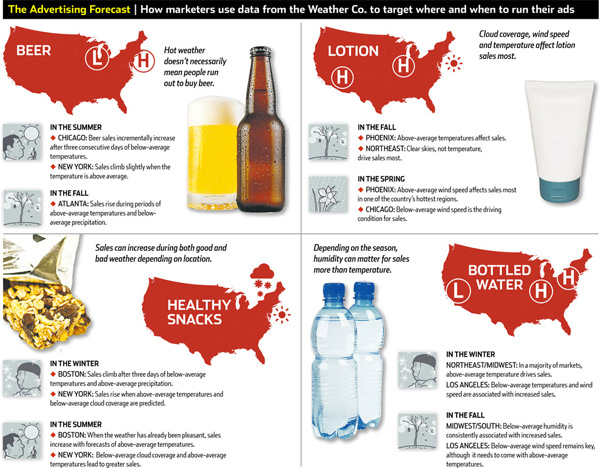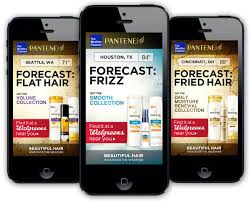An estimated 3 trillion dollars worth of private sector business is driven by the weather, and thanks to climate change, the traditional four-season model is not a reliable predictor of sales.
The good news is big data can forecast weather-dependent product demand, not just in aggregate, but down to the city.
Thermo-targeting in action
Do beer sales increase with hot weather?
Not necessarily – it depends on which city you’re talking about.
Big data says it takes 3 consecutive days of below-average temperatures in Chicago, versus when the temperature is above average in New York.
Healthy snacks spike in the winter after 3 days of below average temperatures, or 3 days of above average precipitation – in Boston. New Yorkers require higher temperatures and clearer winter skies. However, in the summer, healthy snack sales increase when the forecast calls for higher than average temperatures in both cities.
What about lotion sales…in the Spring? In Phoenix, it’s high wind speed that influences sales, versus low speed in Chicago. It’s different in the fall, for different reasons.
These insights come from the Weather Channel’s 75 years of data on weather patterns mashed up with historical purchase patterns, which it uses to target highly contextual mobile ads through its app. Its data is so valuable, its digital ad business drives half of its revenue (which is why the Channel changed its name to the Weather Co.)
Mobile application ads
Amongst the Weather Channel app’s advertisers is Pantene, which targets ads for its strand-smoothing argan oil line to women checking their Weather app on humid days in humid regions, and volumizing products in drier locales.
Hobby chain Michael’s doesn’t target on rainy days, but 3 days in advance of a wet forecast, when crafters think ahead to indoor activities.
But the Weather Channel’s advertisers aren’t the only ones catching on to climate.
Social mobile ads
Molson Canadian beer built its own temperature-targeting tool using the Weather Underground API to check 8 different Canadian cities’ weather in 15 minute intervals. As soon as the mercury hit 23 degrees with sun, it would send mobile Facebook ads that mention the weather, like “Summer heat? Simply say ‘Cider.’”
Tested against non-targeted mobile ads, Molson found click through rates higher, and cost per click 67% lower, thanks to the better performance. And Facebookers were 93 percent more likely to share the ads with friends when weather messaging was included.
Email campaigns
This type of targeting tool could also be integrated with an email system that deploys certain messaging / campaigns when the subscribers’ zip code meets the criteria.
Smart marketers will figure out how to apply this to remarketing. Targeting visitors who viewed your fall boot collection in early August the minute their local weather turns fall-ish may be far more impactful than 30 minutes after they abandoned your site.
Bid management
Integrating the weather’s real-time geographic impact on specific product demand with bid management tools can give you a paid search edge. Chances are, your competition doesn’t have a clue.
For now, at least. Google does hold a patent on serving ads based on local weather conditions identified through sensors on a mobile device, such as temperature, humidity, light and air composition. You may be able to tempo-target your AdWords campaigns sooner than later…
In-store
For retailers that bring digital into their physical stores, digital signage, geo fenced SMS marketing and iBeacons can all deliver weather-specific merchandising and offers that meets the mindset of a customer, rain, shine, hot or cold.
The key to effective personalization is to understand as much about a customer’s context as possible, and real-time, geo-local weather conditions can be a strong piece of this data for many types of products.
But it’s certainly not the most creative piece of context – Google has also patented the targeting of ads based on which sounds surround a device when a user makes a call. For example, if it sounds like a caller is at a concert, the ad network can determine which one based on GPS positioning.
Nothing but exciting times ahead for the digital industry…
And if you liked this article, I suggest you go and read this one too, it is full of super-interesting weather-marketing factoids, including one about Coca-Cola’s best selling product, which you may never even have heard of…





